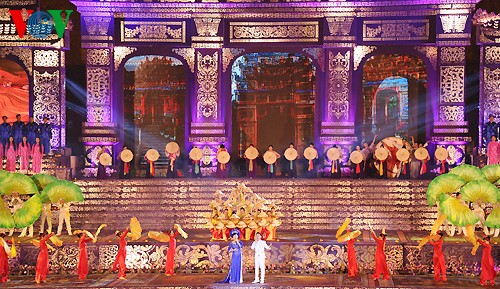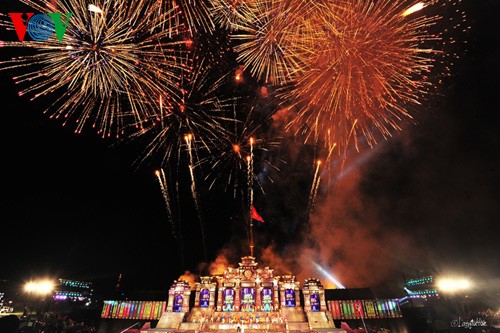(VOVworld) - It has been nearly 3 weeks since we changed the frequency for our summer broadcasts. We have received feedback from listeners on the quality of the changes. From Thibodaux, the US, Allan Fenix emailed us on April 14 to say that VOV’s broadcasts to his place on 12005 khz at 02:30 UTC and 6175 khz at 03:30 UTC were crisp and clear. I confirm that VOV still broadcasts to Eastern America at 01 UTC and 02:30 UTC on 12005 khz and to Central America and the Caribbean at 03:30 UTC on 6175 khz.
B: Bruce Portzer of Seattle, the US, said he heard our shortwave program on April 10th at 03:30 UTC on the frequency of 6175 khz via a relay site in Cypress Creek, the US. The reception quality SINPO was all 4s. He commented: “The overall signal strength was quite good. There was slight interference from a broadcast on an adjacent channel, although I was unsure of the source of the interference. Small amount of atmospheric noise, but no static crashes recorded. There were small variations in the signal strength with no deep fading. The signal was easy to receive and to understand.”
A: Gerry Neumann of England said the frequency 9625 khz at 17 UTC in Europe has not been clear since the change, with occasional slight interference from 9630 khz. We appreciate Gerry’s suggestion that we mention the new frequencies in our Letter Box programs on the two Wednesdays preceding the change, so that everybody will know where to find the broadcast after the change.
B: We often get information about changes from the Broadcasting Section a couple of days before they apply the changes. We’re sorry for any inconvenience you experienced during our frequency changes. At the end of this year’s summer broadcast season, we’ll try to get the change information and inform you earlier.
A: Thank you all for your feedback on the frequencies. It helps our technicians monitor the quality of our broadcasts in different parts of the world. We’ll forward your comments to the technicians and we hope they can do something to improve the situation.
B: In his email on April 15, Gerry shared some ideas he had after listening to our programs: “As a regular visitor to Hue for many years now, I am always keen to hear news about that city, and so I’ve been pleased that the 2014 Hue Festival has been mentioned regularly in the domestic news since Friday, 11th April, the day before the festival started, as well as in the Culture segment on the 11th, and the Culture and Sports events of the week on Sunday 13th.”

A performance at the opening ceremony of the Hue festival 2014 |
A: Gerry continued: “I enjoyed the Sunday Show on April 13th, which featured 2 festivals held by the Cham ethnic group, and the Colourful Vietnam feature on April 14th about the Flowery Mong people’s houses, followed by Personality of the week, about an old artillery soldier of the Dien Bien Phu campaign 60 years ago, who still tells about his experiences to today’s young people. Of course I find the whole program of VOV interesting!”

A fire work displays at the opening ceremony |
B: Thank you Gerry for your detailed reports on our stories. We’re glad that you find our programs relevant and interesting. We hope to see you again one day when you come back to Hue city to work as a volunteer English teacher. From Indonesia, Tjang Pak Ning told us about Tomb Sweeping Day in early April when people visit ancestral tombs and clean them.
A: In Vietnam, we have a similar Sweeping Tomb Day which lasts from early March to late April. We visit our ancestral tombs to pull weeds, plant flowering trees, and pray. This ritual is performed twice a year, at the end and the beginning of the lunar year. We also visit our ancestors’ tombs on their death anniversaries. We have a notion that the world of the dead is similar to that of the living. Offspring should show respect to dead as well as living parents and grandparents.
 |
| Ly Nhon salt farm in Can Gio district |
B: S.B Sharma of India looked at our photos of Ham Tan, the salt-making village in Binh Thuan province. Sharma said: “You are displaying very good pictures of a salt village. People are collecting and transporting the salt. How is this salt making done? Please, describe the process in detail.”
A: Vietnam has many salt-making villages along its 32,000 km coastline. Salt making is much harder than farming. Each year, salt farmers work only in the sunny summer months. First, they dig a pond on the shore to catch sea water. Beside the pond they level two areas, the first one is 15 cm higher than the second one. Both areas are divided and damned up into rectangles 4m x 10m.
B: Sea water is fetched from the pond to the first level area. This water will gradually evaporate over 5 days. Water from the first area is released into the second area every 5 days for about a month. Eventually, the water evaporates and salt crystallizes on the ground. Salt farmers rake the salt into piles until it is dry and then sell it. This traditional method produces around 500 kg of salt per square mater per month.
A: That was a brief introduction to the traditional method of producing salt in Vietnam’s coastal villages. Now, we’ll continue reading listeners’ letters. Stefano Gollino of Italy tuned in to our channel on 9730 khz at 20:30 UTC on Saturday, March 22. He noted good propagation, good signal strength, no interference, and only light atmospheric noise and fading during his reception. The overall signal was clear and understandable.
B: Stefano commented that the program included stories about interesting aspects of Vietnam and songs for entertainment. This week, many listeners commented on our feature “Colorful Vietnam, Vietnam’s 54th ethnic groups” about the traditional costumes of Mong women and how they handmake their dresses. Bhaikan Hazarika of India said he enjoyed the program very much. Descriptions of the customs and traditions of the Mong people and the Mong women’s clothes were informative and fascinating.
A: This week, we acknowledge letters from Allan R. Loudell of Delaware, the US, who said he appreciates the news and current affairs, Andrejs Kuznecovs of Latvia who tuned in to our program on April 13 on 7280 khz and 9730 khz, and Fumito Hokamura of Japan.
B: We’ll confirm your reports with QSL cards and gave you VOV’s latest frequency list. We welcome your feedback at: English section, Overseas Service, Radio Voice of Vietnam, 45 Ba Trieu Street, Hanoi, Vietnam. Or you can email us at: englishsection@vov.org.vn. You’re invited to visit us online at www.vovworld.vn, where you can hear both live and recorded programs. Good bye until next time.